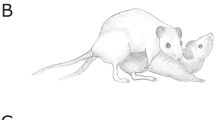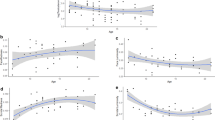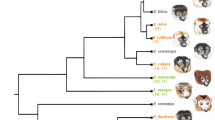Abstract
THE catarrhine monkeys and the apes alone among animals have a clearly defined menstruation with a cycle lasting about 30 days. They do not show well-circumscribed periods of oestrus (heat), but will copulate throughout the cycle. This has led to the idea that the great development of neocortical mechanisms in the primate has resulted in an emancipation of its brain from the influence of gonadal steroids1. Earlier work in both the rhesus monkey2,3 and the chimpanzee4–6, however, has indicated that the level of sexual interaction shows some variation with the phases of the menstrual cycle. Furthermore, studies of the rhesus monkey7,8 have shown that well marked rhythms of mounting behaviour by males occur in relation to the menstrual cycles of their female partners. These rhythms are abolished by bilateral ovariectomy, and so endocrine mechanisms in primate sexual behaviour seem to have been underestimated9.
This is a preview of subscription content, access via your institution
Access options
Subscribe to this journal
Receive 51 print issues and online access
$199.00 per year
only $3.90 per issue
Buy this article
- Purchase on Springer Link
- Instant access to full article PDF
Prices may be subject to local taxes which are calculated during checkout
Similar content being viewed by others
References
Ford, C. S., and Beach, F. A., Patterns of Sexual Behaviour (Eyre and Spottiswoode, London, 1952).
Ball, J., and Hartman, C. G., Amer. J. Obstet. Gynec., 29, 117 (1935).
Carpenter, C. R., J. Comp. Psychol., 33, 113 (1942).
Yerkes, R. M., and Elder, J. H., Comp. Psychol. Monogr., 13, 1 (1936).
Yerkes, R. M., Human Biol., 11, 78 (1939).
Young, W. C., and Orbison, W. D., J. Comp. Psychol., 37, 107 (1943).
Michael, R. P., Proc. Roy. Soc. Med., 58, 595 (1965).
Michael, R. P., and Herbert, J., Science, 140, 500 (1963).
Michael, R. P., in Pathology and Treatment of Sexual Deviation (edit. by Rosen, I.), 24 (Oxford University Press, London, 1964).
Michael, R. P., Herbert, J., and Welegalla, J., J. Endocrinol., 36, 263 (1966).
Michael, R. P., Herbert, J., and Saayman, G., Lancet, i, 1015 (1966).
Author information
Authors and Affiliations
Rights and permissions
About this article
Cite this article
MICHAEL, R., SAAYMAN, G. & ZUMPE, D. Sexual Attractiveness and Receptivity in Rhesus Monkeys. Nature 215, 554–556 (1967). https://doi.org/10.1038/215554a0
Received:
Revised:
Published:
Issue Date:
DOI: https://doi.org/10.1038/215554a0
This article is cited by
-
The role of gonadal hormones in the sexual behavior of the rhesus monkey and human: A literature survey
Archives of Sexual Behavior (1971)
-
Monoamines and ovarian hormone-linked sexual and emotional changes: A review
Archives of Sexual Behavior (1971)
-
Hormonale Beeinflussung des Verhaltens
Klinische Wochenschrift (1971)
-
Oestrogen, Behaviour and Permeability of a Troop of Chacma Baboons
Nature (1968)
-
Pheromones in the Communication of Sexual Status in Primates
Nature (1968)
Comments
By submitting a comment you agree to abide by our Terms and Community Guidelines. If you find something abusive or that does not comply with our terms or guidelines please flag it as inappropriate.



